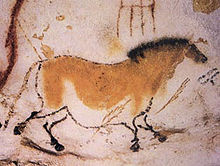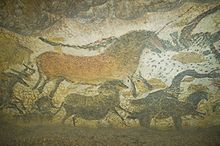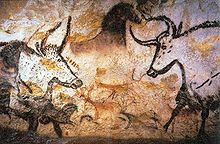Lascaux
Lascaux is the setting of a complex of caves in southwestern France famous for its Paleolithic cave paintings. The original caves are located near the village of Montignac, in the department of Dordogne. They contain some of the best-known Upper Paleolithic art. These paintings are estimated to be 17,300 years old.[1][2] They primarily consist of primitive images of large animals, most of which are known from fossil evidence to have lived in the area at the time. In 1979, Lascaux was added to the UNESCO World Heritage Sites list along with other prehistoric sites in the Vézère valley.[3]
Contents[hide] |
[edit] History
The cave was discovered on September 12, 1940 by four teenagers, Marcel Ravidat, Jacques Marsal, Georges Agnel, and Simon Coencas, as well as Marcel's dog, Robot.[4] The cave complex was opened to the public in 1948.[5] By 1955, the carbon dioxide produced by 1,200 visitors per day had visibly damaged the paintings. The cave was closed to the public in 1963 in order to preserve the art. After the cave was closed, the paintings were restored to their original state, and were monitored on a daily basis. Rooms in the cave include The Hall of the Bulls, the Passageway, the Shaft, the Nave, the Apse, and the Chamber of Felines.
Lascaux II, a replica of two of the cave halls — the Great Hall of the Bulls and the Painted Gallery — was opened in 1983, 200 meters from the original.[4] Reproductions of other Lascaux artwork can be seen at the Centre of Prehistoric Art at Le Thot, France.
Since 1998 the cave has been beset with a fungus, variously blamed on a new air conditioning system that was installed in the caves, the use of high-powered lights, and the presence of too many visitors.[6] As of 2008, the cave contained black mold which scientists were and still are trying to keep away from the paintings. In January 2008, authorities closed the cave for three months even to scientists and preservationists. A single individual was allowed to enter the cave for 20 minutes once a week to monitor climatic conditions. Now only a few scientific experts are allowed to work inside the cave and just for a few days a month but the efforts to remove the mold have taken a toll, leaving dark patches and damaging the pigments on the walls.[7]
In its sedimentary composition, the Vézère drainage basin covers one fourth of the département of the Dordogne, the northernmost region of the Black Perigord. Before joining the Dordogne River near Limeuil, the Vézère flows in a south-westerly direction. At its centre point, the river's course is marked by a series of meanders flanked by high limestone cliffs that determine the landscape. Upstream from this steep-sloped relief, near Montignac and in the vicinity of Lascaux, the contours of the land soften considerably – the valley floor widens, and the banks of the river lose their steepness. The Lascaux valley is located some distance from the major concentrations of decorated caves and inhabited sites, most of which were discovered further downstream. In the environs of the village of Eyzies-de-Tayac Sireuil, one finds no less than 37 decorated caves and shelters, as well as an even greater number of habitation sites from the Upper Palaeolithic, located in the open, beneath a sheltering overhand, or at the entrance to one of the area's karst cavities. This is the highest concentration in western Europe.
[edit] The images
The cave contains nearly 2,000 figures, which can be grouped into three main categories — animals, human figures and abstract signs. Notably, the paintings contain no images of the surrounding landscape or the vegetation of the time.[8][not in citation given] Most of the major images have been painted onto the walls using mineral pigments, although some designs have also been incised into the stone. Many images are too faint to discern, and others have deteriorated entirely.
Over 900 can be identified as animals, and 605 of these have been precisely identified. There are also many geometric figures. Of the animals, equines predominate, with 364 images. There are 90 paintings of stags. Also represented are cattle and bison, each representing 4-5% of the images. A smattering of other images include seven felines, a bird, a bear, a rhinoceros, and a human. Among the most famous images are four huge, black bulls or aurochs in the Hall of the Bulls. There are no images of reindeer, even though that was the principal source of food for the artists.[9]
The most famous section of the cave is The Great Hall of the Bulls where bulls, equines and stags are depicted. The four black bulls are the dominant figures among the 36 animals represented here. One of the bulls is 17 feet (5.2 m) long — the largest animal discovered so far in cave art. Additionally, the bulls appear to be in motion.[10]
A painting referred to as "The Crossed Bison" and found in the chamber called the Nave is often held as an example of the skill of the Paleolithic cave painters. The crossed hind legs create the illusion that one bison is closer to us than the other. This visual depth in the scene demonstrates a primitive form of perspective which was particularly advanced for the time.
In recent years, new research has suggested that the Lascaux paintings may incorporate prehistoric star charts. Dr Michael Rappenglueck of the University of Munich argues that some of the non-figurative dot clusters and dots within some of the figurative images correlate with the constellations of Taurus, The Pleiades and the grouping known as the "Summer Triangle".[11] Based on her own study of the astronomical significance of Bronze Age petroglyphs in the Vallée des Merveilles[12] and her extensive survey of other prehistoric cave painting sites in the region — most of which appear to have been specifically selected because the interiors are illuminated by the setting sun on the day of the winter solstice — French researcher Chantal Jègues-Wolkiewiez has further proposed that the gallery of figurative images in the Great Hall represents an extensive star map and that key points on major figures in the group correspond to stars in the main constellations as they appeared in the Paleolithic.[13][14]
An alternative hypothesis proposed by David Lewis-Williams following work with similar art of the San people of Southern Africa is that this type of art is spiritual in nature relating to visions experienced during ritualistic trance-dancing. These trance visions are a function of the human brain and so are independent of geographical location. Nigel Spivey, a professor of classic art and archeology at the University of Cambridge, has further postulated in his series, How Art Made the World, that dot and lattice patterns overlapping the representational images of animals are very similar to hallucinations provoked by sensory-deprivation. He further postulates that the connections between culturally important animals and these hallucinations led to the invention of image-making, or the art of drawing. Further extrapolations include the later transference of image-making behavior from the cave to megalithic sites, and the subsequent invention of agriculture to feed the site builders.
Some anthropologists and art-historians also theorize that the paintings could be an account of past hunting success, or could represent a mystical ritual in order to improve future hunting endeavors. This latter theory is supported by the overlapping images of one group of animals in the same cave-location as another group of animals, suggesting that one area of the cave was more successful for predicting a plentiful hunting excursion. Daniel Quinn, in The Story of B, hypothesizes that the paintings were instructional in nature, created in order to communicate successful hunting strategies.
In literature, one author has suggested the "artistic decoration has much more of the atmosphere of a nursery ... I have conceived a child as standing in the cave; and it is easy to conceive any child, modern or immeasurably remote, as making a living gesture as if to pat the painted beasts upon the wall."[15]
Applying to the Lascaux paintings the iconographic method of analysis (studying position, direction and size of the figures; organization of the composition; painting technique; distribution of the color planes; research of the image center), Thérèse Guiot-Houdart endeavoured to comprehend the symbolic function of the animals, to identify the theme of each image and finally to reconstitute the canvas of the myth illustrated on the rockwalls.[16]
[edit] Threats
The opening of the Lascaux cave after World War II changed the cave environment. The breathing of 1,200 visitors per day, presence of lighting and changes in air circulation have created a number of problems. In the late 1950s appearance of lichens and crystals on the walls led to closure of the caves in 1963. This led to restriction of access to the real caves to a few visitors every week and the creation of a replica cave for visitors to Lascaux. In 2001, the authorities in charge of Lascaux changed the air conditioning system which resulted in regulation of the temperature and humidity. When the system had been established, an infestation of Fusarium solani, a white mold, began spreading rapidly across the cave ceiling and walls.[17] The mold is considered to have been present in the cave soil and exposed by the working of tradesmen, leading to the spread of the fungus which was treated with quicklime. Since 2007, a new fungus, which has created grey and black blemishes, has begun spreading in the real cave.
The problem is ongoing and efforts are on to control the microbial and fungal growth in the cave. The fungal infection crises have led to the establishment of an International Scientific Committee for Lascaux and rethinking of how and how much human access should be permitted in caves containing prehistoric art.[18]
[edit] See also
| Wikimedia Commons has media related to: Lascaux |
- Cave of Altamira
- Prehistoric art
- List of archaeological sites sorted by country
- European archaeology
- List of caves
- Cave painting
[edit] References
- ^ Capelo, Holly (July 2010). "Symbols from the Sky: Heavenly messages from the depths of prehistory may be encoded on the walls of caves throughout Europe.". Seed Magazine. http://seedmagazine.com/content/article/symbols_from_the_sky. Retrieved January 2011.
- ^ merlynne6 (2009). "What the Lascaux Cave Paintings Tell Us About How Our Ancestors Understood the Stars". http://www.environmentalgraffiti.com/sciencetech/what-the-lascaux-cave-paintings-tell-us-about-how-our-ancestors-understood-the-stars/15506. Retrieved January 2011.
- ^ Prehistoric Sites and Decorated Caves of the Vézère Valley. UNESCO World Heritage Centre. http://whc.unesco.org/en/list/85
- ^ a b Bahn, Paul G. (2007). Cave Art. Frances Lincoln. pp. 81–85. ISBN 0711226555
- ^ Littlewood, Ian (2002, 2005). A Timeline History of France. Barnes & Noble. p. 296. ISBN 0-7607-7975-9
- ^ Lichfield, John (12 July 2008). "Six months to save Lascaux". The Independent. http://www.independent.co.uk/news/world/europe/six-months-to-save-lascaux-865819.html
- ^ Moore, Molly (1 July 2008). "Debate Over Moldy Cave Art Is a Tale of Human Missteps". Washington Post. http://www.washingtonpost.com/wp-dyn/content/article/2008/06/30/AR2008063002363.html (requires free registration)
- ^ The Cave of Lascaux official website — Themes
- ^ Gregory Curtis, The Cave Painters: Probing the Mysteries of the World's First Artists, Knopf, New York, NY, USA, 2006. 1-4000-4348-4, pp. 96-97
- ^ Gregory Curtis, The Cave Painters: Probing the Mysteries of the World's First Artists, Knopf, New York, NY, USA, 2006. 1-4000-4348-4, p. 102
- ^ Whitehouse, David (9 August 2000). Ice Age star map discovered. BBC News. http://news.bbc.co.uk/2/hi/science/nature/871930.stm
- ^ "Vallée des Merveilles" (in French). Archeociel. http://www.archeociel.com/nouvelle.htm. Retrieved January 2011.
- ^ "Archeociel : Chantal Jègues Wolkiewiez" (in French). http://www.archeociel.com. Retrieved January 2011.
- ^ "The Lascaux cave: a Prehistoric sky-map...". lightmeditation. http://issuu.com/lightmediation/docs/the_lascaux_cave___a_prehistoric_sky-map_3390?mode=embed&documentId=080926150256-7f1d39d0e87c4e28a7515a2712d1e473&layout=grey. Retrieved January 2011.
- ^ Chesterton, G.K. (1925). "The Everlasting Man". http://www.cse.dmu.ac.uk/~mward/gkc/books/everlasting_man.html#chap-I-i. Retrieved January 2011.
- ^ Guiot-Houdart, Thérèse (2004) (in French). Lascaux et les mythes. Périgueux: Pilote 24. ISBN 2-912347-39-4.
- ^ Joëlle Dupont, Claire Jacquet, Bruno Dennetière, Sandrine Lacoste (2007). "Invasion of the French Paleolithic painted cave of Lascaux by members of the Fusarium solani species complex". Mycologia 99 (4): 526–533. doi:10.3852/mycologia.99.4.526. PMID 18065003. http://www.mycologia.org/cgi/content/abstract/99/4/526.
- ^ Simons, Marlise (9 December 2007). "Fungus Once Again Threatens French Cave Paintings". World:Europe. New York Times. http://www.nytimes.com/2007/12/09/world/europe/09cave.html?_r=1&ref=world. Retrieved 15 October 2010.
[edit] Further reading
- Curtis, Gregory (2006). The Cave Painters: Probing the Mysteries of the World's First Artists. New York, New York, USA: Knopf. ISBN 1-4000-4348-4
- Lewis-Williams, David (2004). The Mind in the Cave: Consciousness and the Origins of Art. Thames and Hudson. ISBN 0-500-28465-2
- Bataille, Georges (2005). The Cradle of Humanity: Prehistoric Art and Culture. New York, New York: Zone Books. ISBN 1-890951-55-2
- Joseph Nechvatal, "Immersive Excess in the Apse of Lascaux", Technonoetic Arts 3, no3. 2005
- B.et G. Delluc (dir.), Le Livre du Jubilé de Lascaux 1940-1990, Société historique et archéologique du Périgord, supplément au tome CXVII, 1990, 155 p., ill.
- B. et G. Delluc, 2003 : Lascaux retrouvé. Les recherches de l'abbé André Glory, Pilote 24 édition, 368 p., ill.
- B. et G. Delluc, 2006 : Discovering Lascaux, Sud Ouest, nouvelle édition entièrement revue et très augmentée, 80 p., ill. plans et coupe.
- B. et G. Delluc, 2008 : Dictionnaire de Lascaux, Sud Ouest, Bordeaux. Plus de 600 entrées et illustrations. Bibliographie (450 références). ISBN 978-2-87901-877-5.
- B. et G. Delluc, 2010 : Lascaux et la guerre. Une galerie de portraits, Bull. de la Soc. historique et arch. du Périgord, CXXXVI, 2e livraison, 40 p., ill., bibliographie.
- A. Glory, 2008 : Les recherches à Lascaux (1952-1963). Documents recueillis et présentés par B. et G. Delluc, XXXIXe suppl. à Gallia-Préhistoire, CNRS, Paris.
[edit] External links
- Lascaux Cave Official Lascaux Web site, from the French Ministry of Culture
- Save Lascaux Official website of the International Committee for the Preservation of Lascaux
- Lascaux Cave Art Symposium The Bradshaw Foundation
Coordinates: 45°02′57″N 1°10′34″E / 45.04917°N 1.17611°E



